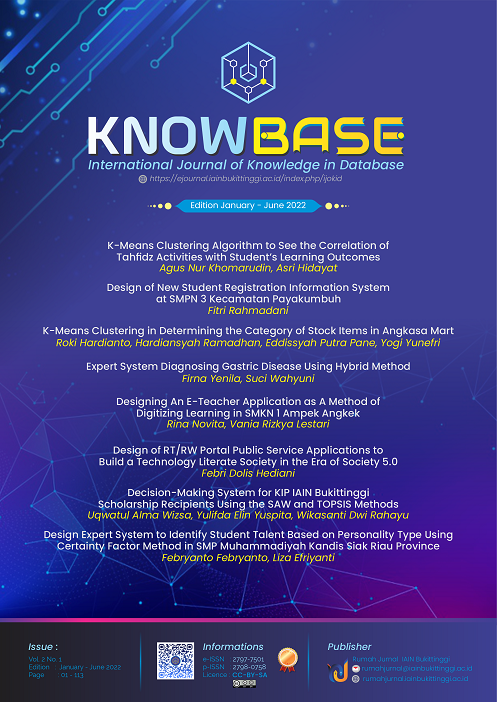K-Means Clustering in Determining the Category of Stock Items In Angkasa Mart
DOI:
https://doi.org/10.30983/ijokid.v2i1.5411Keywords:
Clustering, K-Means, Web-BasedAbstract
A good and accurate stock management system is crucial in any institution or organization that conducts product buying and selling transactions. This is done to improve stock efficiency, reduce storage costs, be more effective, and meet customer expectations. This research produced three groups of the most desirable products for large stock quantities, moderate stock quantities for products of interest, and low stock quantities for products that were less or not in demand. Data was processed using the clustering method, specifically the K-Means method, which was based on historical sales data that includes the product code, number of transactions, and average sales. This study was carried out using web-based calculations. Testing with the rapid miner application. The research yielded three members of the product group for large stock, 238 large stock, 273 medium stock, and 25 low stock.References
Y. R. Sari, A. Sudewa, D. A. Lestari, and T. I. Jaya, “Penerapan Algoritma K-Means Untuk Clustering Data Kemiskinan Provinsi Banten Menggunakan Rapidminer,†CESS (Journal Comput. Eng. Syst. Sci., vol. 5, no. 2, p. 192, 2020, doi: 10.24114/cess.v5i2.18519.
M. L. Sibuea and A. Safta, “Pemetaan Siswa Berprestasi Menggunakan Metode K-Means Clustring,†Jurteksi, vol. 4, no. 1, pp. 85–92, 2017, doi: 10.33330/jurteksi.v4i1.28.
D. N. Batubara, A. P. Windarto, D. Hartama, and H. Satria, “Analisis Metode K-MEANS Pada Pengelompokan Keberadaan Area Resapan Air Menurut Provinsi,†Semin. Nas. Sains Teknol. Inf., no. x, pp. 345–349, 2019, [Online]. Available: https://prosiding.seminar-id.com/index.php/sensasi/article/view/324 (05 Juni 2020).
E. Muningsih and S. Kiswati, “Penerapan Metode K-Means Untuk Clustering Produk Online Shop Dalam Penentuan Stok Barang,†J. Bianglala Inform., vol. 3, no. 1, pp. 10–17, 2015.
R. D. Ramadhani, “Data Mining Menggunakan Algoritma K-Means Clustering Untuk Menentukan Strategi Promosi Universitas Dian Nuswantoro,†Ind. Mark. Manag., vol. 1, no. 1, pp. 1–9, 2014, [Online]. Available: http://dx.doi.org/10.1016/j.indmarman.2016.05.016.
R. Ordila, R. Wahyuni, Y. Irawan, and M. Yulia Sari, “Penerapan Data Mining Untuk Pengelompokan Data Rekam Medis Pasien Berdasarkan Jenis Penyakit Dengan Algoritma Clustering (Studi Kasus : Poli Klinik PT.Inecda),†J. Ilmu Komput., vol. 9, no. 2, pp. 148–153, 2020, doi: 10.33060/jik/2020/vol9.iss2.181.
P. A. Ariawan, “Optimasi Pengelompokan Data Pada Metode K-means dengan Analisis Outlier,†J. Nas. Teknol. dan Sist. Inf., vol. 5, no. 2, pp. 88–95, 2019, doi: 10.25077/teknosi.v5i2.2019.88-95.
R. Rosmini, A. Fadlil, and S. Sunardi, “Implementasi Metode K-Means Dalam Pemetaan Kelompok Mahasiswa Melalui Data Aktivitas Kuliah,†It J. Res. Dev., vol. 3, no. 1, pp. 22–31, 2018, doi: 10.25299/itjrd.2018.vol3(1).1773.
W. M. P. Dhuhita, “Clustering Menggunakan Metode K-Means Untuk,†J. Inform., vol. 15, no. 2, pp. 160--174, 2016.
K. Fatmawati and A. P. Windarto, “Data Mining: Penerapan Rapidminer Dengan K-Means Cluster Pada Daerah Terjangkit Demam Berdarah Dengue (Dbd) Berdasarkan Provinsi,†Comput. Eng. Sci. Syst. J., vol. 3, no. 2, p. 173, 2018, doi: 10.24114/cess.v3i2.9661.
N. Rofiqo, A. P. Windarto, and D. Hartama, “Penerapan Clustering Pada Penduduk Yang Mempunyai Keluhan Kesehatan Dengan Datamining K-Means,†KOMIK (Konferensi Nas. Teknol. Inf. dan Komputer), vol. 2, no. 1, pp. 216–223, 2018, doi: 10.30865/komik.v2i1.929.
Downloads
Submitted
Accepted
Published
Issue
Section
License
Authors who publish with this journal agree to the following terms:
- Authors retain copyright and grant the journal right of first publication with the work simultaneously licensed under a Creative Commons Attribution License that allows others to share the work with an acknowledgment of the work's authorship and initial publication in this journal.
- Authors are able to enter into separate, additional contractual arrangements for the non-exclusive distribution of the journal's published version of the work (e.g., post it to an institutional repository or publish it in a book), with an acknowledgment of its initial publication in this journal.
- Authors are permitted and encouraged to post their work online (e.g., in institutional repositories or on their website) prior to and during the submission process, as it can lead to productive exchanges, as well as earlier and greater citation of published work (See The Effect of Open Access).














